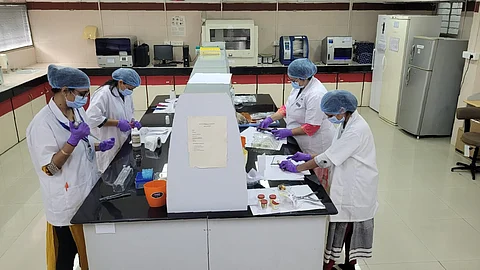Identifying the Victims: A Difficult but Necessary Process
The crash and resulting fire have made many of the bodies difficult or impossible to identify. To support grieving families, the Gujarat Health and Family Welfare Department has set up DNA collection and testing facilities at BJ Medical College.
More than 200 DNA samples have already been collected. Some came from remains at the crash site, while others were submitted by family members who travelled from across India and overseas, hoping for answers.
Authorities at Ahmedabad Civil Hospital confirmed that DNA matching has so far identified 47 victims, and the mortal remains of 24 individuals have already been returned to grieving families. Most of the identified victims were from Rajasthan and various parts of Gujarat, according to Dr. Rajnish Patel, Head of Surgery at the hospital.
Officials estimate that DNA testing will take up to 72 hours for each case. Families of passengers who are still abroad have been contacted, and their samples will be collected once they arrive in India.
A dedicated team of forensic experts is working around the clock to complete the identification process. The work has been taken up on a war footing by Gandhinagar’s Forensic Science Laboratory (FSL). FSL Director H. P. Sanghvi explained that DNA extraction, particularly from charred remains such as bones and teeth, is a time-intensive and intricate process.
The samples are first cleaned and ground into powder before undergoing DNA extraction at controlled temperatures using specialized equipment. The extracted DNA is then evaluated for quality and quantity using RT-PCR machines. Only those samples that meet stringent quality standards are sequenced further to produce a full DNA profile.
If a sample fails to show sufficient DNA alleles, the entire process must be repeated. For identification to be confirmed, at least 23 alleles must match between the victim and their relative. In specific cases, such as father-son identifications, Y-chromosome analysis is also conducted.
Among the identified victims is Gujarat’s former Chief Minister Vijay Rupani, whose remains were matched through this exhaustive process.
Gujarat Home Minister Harsh Sanghavi paid tribute to the 36-member forensic team for their extraordinary commitment. He shared that some team members are working despite immense personal hardships. One expert continues with testing while his mother is critically ill and awaiting surgery. Eight women scientists on the team are mothers of children aged three years or less, yet they have set aside their family responsibilities to remain at the lab. Sanghavi called their service a profound example of professionalism and selflessness in the face of tragedy.


